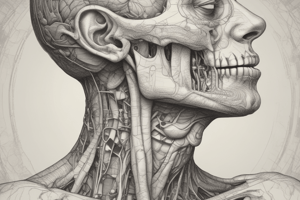Podcast
Questions and Answers
What is the main function of the larynx?
What is the main function of the larynx?
- Producing sound for speech (correct)
- Filtering and warming the air
- Assisting in the compression of the abdomen
- Facilitating gas exchange
Which of the following is not part of the upper respiratory system?
Which of the following is not part of the upper respiratory system?
- Trachea (correct)
- Pharynx
- Larynx
- Nose
What is the primary function of the nasal cavity?
What is the primary function of the nasal cavity?
- Gas exchange
- Filtering and warming the air (correct)
- Phonation
- Assisting in the compression of the abdomen
Which part of the respiratory system is responsible for the resonance of speech?
Which part of the respiratory system is responsible for the resonance of speech?
What is the main function of the pharynx?
What is the main function of the pharynx?
What is the main function of the trachea?
What is the main function of the trachea?
What is the term for tubes smaller than 1 mm that are found in the respiratory system?
What is the term for tubes smaller than 1 mm that are found in the respiratory system?
Which part of the lung is related to the sternum and ribs?
Which part of the lung is related to the sternum and ribs?
What is the outer layer of the pleural membrane that comes in contact with the inner wall of the thorax and mediastinum called?
What is the outer layer of the pleural membrane that comes in contact with the inner wall of the thorax and mediastinum called?
Which bronchi have a characteristic formation of 3 lobar bronchi on the right side and 2 lobar bronchi on the left side?
Which bronchi have a characteristic formation of 3 lobar bronchi on the right side and 2 lobar bronchi on the left side?
What is the space within the pleural sac that contains a small amount of serous fluid called?
What is the space within the pleural sac that contains a small amount of serous fluid called?
Where do respiratory bronchioles divide from in the respiratory system?
Where do respiratory bronchioles divide from in the respiratory system?
Which of the following is NOT a part of the pharynx?
Which of the following is NOT a part of the pharynx?
What is the primary function of the vocal folds?
What is the primary function of the vocal folds?
Which structure is NOT a cartilage found in the larynx?
Which structure is NOT a cartilage found in the larynx?
What is the primary function of the trachea?
What is the primary function of the trachea?
Where is the nasopharynx located?
Where is the nasopharynx located?
What is the role of the epiglottis during swallowing?
What is the role of the epiglottis during swallowing?
Flashcards are hidden until you start studying
Study Notes
Respiratory System
- The main organ of the respiratory system is the lungs
- Main functions of the respiratory system:
- Gas exchange
- Sound production
- Assistance in compression of the abdomen
- Breathing consists of two phases:
- Inspiration: the process of taking in air
- Expiration: the process of blowing out air
Upper and Lower Respiratory System
- Upper respiratory system:
- Nose
- Larynx
- Pharynx
- Lower respiratory system:
- Trachea
- Bronchi
- Lungs
Conducting and Respiratory Zones
- Conducting zone:
- Respiratory passages that carry air to the site of gas exchange
- Filters, humidifies, and warms air
- Consists of nose, pharynx, larynx, trachea, and bronchial tree
- Respiratory zone:
- Site of gas exchange
- Composed of respiratory bronchioles, alveolar ducts, and alveolar sacs
Nose and Nasal Cavity
- The nose is the organ of smell
- Found on the anterior aspect of the face
- The nasal cavity is divided into right and left cavities by the nasal septum
- Communicates posteriorly with the pharynx
Trachea and Bronchi
- The trachea is a fibromuscular tube, 13 cm long
- Main (primary) bronchi divide into secondary (lobar) bronchi, each supplying one lobe
- 3 lobar bronchi on the right and 2 lobar bronchi on the left
- Lobar bronchi branch into tertiary bronchi and continue dividing about 23 times
Lungs
- Each lung is half-cone shaped with 3 surfaces, 3 borders, apex, and base
- Apex is directed upwards and lies deep to the clavicle
- Base is directed downwards and rests on the diaphragm
- Surfaces: costal, diaphragmatic, and medial
- Borders: anterior, inferior, and posterior
Pleura
- Pleural membranes are closed serous sacs
- Consists of two layers:
- Visceral pleura (inner layer in contact with the lung)
- Parietal pleura (outer layer in contact with the inner wall of the thorax and mediastinum)
- Pleural cavity is the space within the pleural sac, containing a small amount of serous fluid
Pharynx
- Pharynx is a tube-like structure that extends from the base of the skull to the 6th cervical vertebra
- Divided into three parts: nasopharynx, oropharynx, and laryngopharynx
- Oropharynx and laryngopharynx serve as a common pathway for food and air
Studying That Suits You
Use AI to generate personalized quizzes and flashcards to suit your learning preferences.




